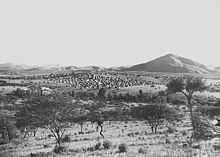Old Location


The Old Location (or as it was known then the Main Location) was an area segregated for Black residents of Windhoek, the capital of Namibia. It was situated in the area of today's suburbs Hochland Park and Pioneers Park.
Upon the creation of the neighborhood in 1912 by the Windhoek City Council, all Black residents of other areas of the city were moved to the Main Location. A year later, streets were laid out and the separation of Black ethnic groups took place, with each ethnic group forced to live in a different section. Administration of the area was split between Black local residents and White residents from elsewhere.
Old Location Uprising
Background
After World War I the League of Nations gave South-West Africa, formerly a German colony, to the United Kingdom as a mandate under the title of South Africa.[1] When the National Party won the 1948 election in South Africa and subsequently introduced apartheid legislation,[2] these laws also extended into South-West Africa which was the de facto fifth province of South Africa.[3]
During the 1950s, the Windhoek municipality and the South African colonial administration decided to forcefully move the residents of the Main Location 8 kilometres (5.0 mi) to the north of the city, prompting the evicted people to give the new location the name Katutura (Otjiherero: The place where we do not want to live).[4]
For a number of reasons most residents did not want to move: They had owned the erven in Old Location whereas in Katutura all land belonged to the municipality. The newly allocated erven were also a lot smaller than those in Old Location, effectively forbidding the creation of gardens. Also economically black residents were worse off after the move because they now had to pay rent to the municipality, and they needed a bus to reach their work places in town—Old Location had been in walking distance.[5]
Events on 10 December 1959
The newly established SWANU party, in one their first mass actions, organised the protest of the inhabitants which came to a head in December 1959.[6] Following protests and an effective boycott of municipal services by Main Location residents, the police opened fire on the protesters, killing 11 and wounding 44 others. Doctors at the hospitals in Windhoek refused to treat the wounded, telling them to "go to the United Nations for treatment because these people ... [are] political patients".[7] Although this claim is backed by many eyewitnesses, among them Sam Nujoma, Namibia's founding president who references the incident in his autobiography Where Others Wavered, it has not been unchallenged. Hannes Smith caused a controversy in 2003, calling it a "gross lie".[8]
3,000-4,000 residents fled the area and refused to return, fearing police reprisals. The Old Location Uprising, as it came to be known, was a rallying cry for Namibian independence until the country received independence in March 1990, 31 years later.[9][10] It was one of the events leading to the foundation of SWAPO[11] by forcing community leaders from the Ovamboland People's Organization into exile, including Sam Nujoma.[4] It is also probably one of the main reasons for SWAPO to put less effort into petitioning and resistance, and to turn the independence struggle into an armed conflict.[12]
The Old Location uprising is the reason for the declaration of December 10, Human Rights Day, as a Namibian national holiday.
Transfer to Katutura
The transfer to the Katutura suburb took several years. In 1962, approximately 7,000 people had been moved, joining the 2,000 people of Ovambo descent that already lived there.[13]
In 1968, the Old Location was officially closed and whites began to settle.
Notable residents
- Joseph Obgeb Jimmy, diplomat[14]
- Anna Mungunda, National Hero of Namibia, a domestic worker killed in the uprising of 1959[15]
References
- ↑ Eerikäinen, Marjo (14 July 2008). "The South Africa Mandate 1915-1989". Vantaa. Retrieved 15 March 2011.
- ↑ "Formation of the South African Republic". South Africa History Online. Retrieved 15 April 2011.
- ↑ "Namibia: Apartheid, resistance and repression (1945-1966)". Electoral Institute for the Sustainability of Democracy in Africa. August 2009. Retrieved 15 April 2011.
- ↑ 4.0 4.1 Dierks, Klaus. "History of Namibia, 1959". klausdierks.com. Retrieved 10 February 2012.
- ↑ "Onafhanklikheid ook Ou Lokasie se vrug" [Independence also a result of Old Location]. Die Republikein (in Afrikaans). 16 December 2011.
- ↑ Rotberg, Robert I (1980). Suffer the Future: Policy Choices in Southern Africa (illustrated ed.). Harvard University Press. p. 207. ISBN 0674854012.
- ↑ Dierks, Klaus. "BIOGRAPHIES OF NAMIBIAN PERSONALITIES (Entry for Schimming-Chase, Nora)". Retrieved 7 May 2010.
- ↑ Nujoma's war of words with editor in the Mail & Guardian, 30 August 2003
- ↑ History of Old Location and Katutura NamibWeb.com
- ↑ Forced Removal from Old Location Vantaa.fi
- ↑ Peter N. Stearns and William Leonard Langer. The Encyclopedia of World History: Ancient, Medieval, and Modern, Chronologically Arranged, 2001. Page 1070.
- ↑ Reginald Herbold Green (ed.). "Namibia". Encyclopædia Britannica. Retrieved 15 February 2012.
- ↑ "Die Bewohner von Katutura" [The inhabitants of Katutura]. Allgemeine Zeitung (in German). 15 August 1962.
- ↑ Mvula ya Nangolo: Joseph Jimmy: freedom fighter and bridge builder The Namibian, 6 February 2004
- ↑ Angula, Nahas (10 December 2010). "Old location massacre: the spark that ignited the struggle for national independence". Speeches of the Prime Minister. Government of Namibia.